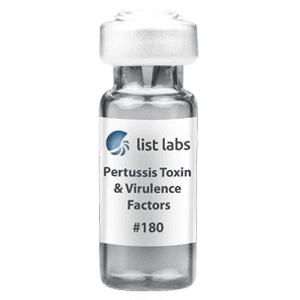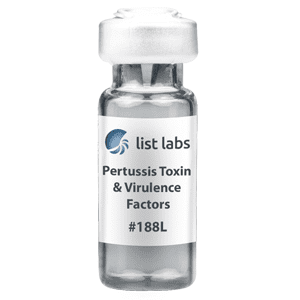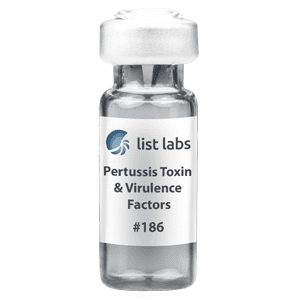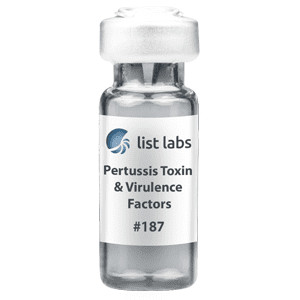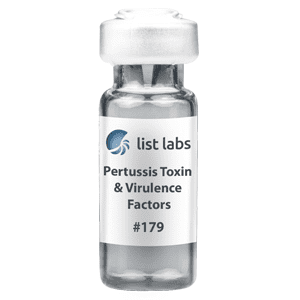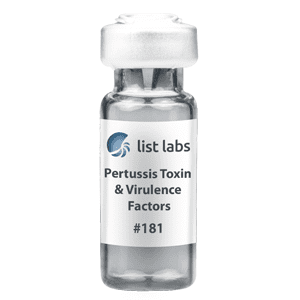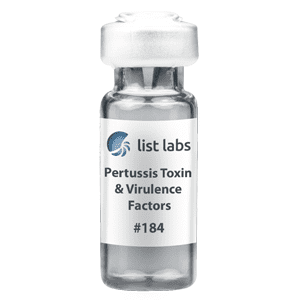Description
Pertussis Toxin from B. pertussis, Lyophilized in Buffer
View Special Shipment Requirements
Products are for research purposes only and are
not for use in humans or as diagnostic agents.
View our other Pertussis Toxin and Virulence Factors Products
$500.00
#180 (50 ug)
Purity
Form
Storage temp
Description
Pertussis Toxin
Pertussis toxin (PT), a virulence factor produced by Bordetella pertussis, is a multi-subunit toxin which binds to most cultured mammalian cells and targets specific G protein, inhibiting the ability of the G protein to function in signaling pathways. Depending on the function of the G protein, the effects of PT can vary. This ability to inhibit pathways utilizing the Gi family of protein-coupled receptors is the basis of the use of PT as a tool in cell biology. PT plays a role in infection by suppressing and modulating various host immune responses to Bordetella pertussis. PT has been used to stimulate experimental autoimmune diseases in rodent models, such as experimental auto immune encephalitis (EAE).
Native pertussis toxin is provided as a consistent product in three different formulations. Pertussis toxin is lyophilized either in buffer (Product # 180) or in pure water (Product # 181). Additionally, pertussis toxin is sold in a glycerol solution (Product # 179). These products are listed below.
List Labs sells a genetically inactivated form of pertussis toxin, Pertussis Toxin Mutant. This protein may be used as antigens and as carrier proteins for other antigens. Although an amino acid in the enzyme active site is altered and activity is diminished, this mutant retains some of the activity of the native toxin. For more details about the genetically inactivated toxin follow the link to Pertussis Toxin Mutant.
Pertussis toxin is a multi-component protein composed of six non-covalently bound subunits ranging in molecular weight from approximately 9 to 28 kDa. These subunits are designated as S1, S2, S3, S4 and S5 and occur in native pertussis toxin in a ratio of 1:1:1:2:1, where the subunit S4 is present in two copies. The largest subunit S1, also called the A protomer, is responsible for the ADP-ribosyltransferase activity; the A protomer alone will transfer the ADP ribose from NAD+ to α subunits of G proteins of the class Gαi, Gαo or Gαt. The crystal structure of PTX reveals a pyramid-like shape with the A protomer situated on top of the S5 subunit which rests on two dimers, S2-S4 and S3-S4. Together the five subunit platform is called the B oligomer and under certain conditions PTX dissociates into just two parts, the enzymatic A protomer and the five subunit, binding complex, the B oligomer. This B oligomer allows PTX to enter most cells, attaching to glycan residues present on receptor proteins including TLR4 and glycoprotein Ib. After entering the cell via receptor-mediated endocytosis, PTX is transported retrogradely via the endosomal pathway and Golgi complex to the endoplasmic reticulum. A protomer is released from the toxin and translocates through the membrane of the endoplasmic reticulum where the toxin inactivates the target membrane-bound G proteins.
Bordetella pertussis virulence factors derived from native organisms and offered by List Labs, include Pertussis Toxin Subunits, Pertussis Toxin Mutant, Filamentous Hemagglutinin (FHA), Fimbriae 2/3, Pertactin (69 kDa protein), Adenylate Cyclase Toxin (ACT), Adenylate Cyclase Antigen and B. pertussis Lipopolysaccharide (LPS). More information about each of these products may be obtained through the links on the Bordetella Virulence Factors.
Additional information
| Weight | N/A |
|---|---|
| Dimensions | N/A |
| Destination |

